ISSN ONLINE(2278-8875) PRINT (2320-3765)
ISSN ONLINE(2278-8875) PRINT (2320-3765)
K. Sanjeeva Rao1, G. Gunasekaran2
|
| Related article at Pubmed, Scholar Google |
Visit for more related articles at International Journal of Advanced Research in Electrical, Electronics and Instrumentation Engineering
In the recent communication applications the need for antenna pattern synthesis and the radiation steering is very much desirable to deal with some of the problems in communications. Especially in the domain of multiplexing to give the same channel in multiple directions to get more efficient frequency spectrum appropriate adaptive antennas are desirable. In this paper we design a two-layered model of HIS to shift the radiation energy from theta=0° to theta=45 and 135° direction by using the rotation of inner hidden layer. And the radiation pattern is presented in the results.
Keywords |
| Rotatable Patch, HIS, Radiation Steering, Two-Layer |
INTRODUCTION |
| From past two decades High Impedance Ground planes proved very useful in enhancing the antenna parameters without changing the antenna physically. Due to its properties and TE and TM modes exhibiting in the presence of antenna [1]. It may enhance radiation pattern are absorb it. When placed as replacement for conventional ground plane it will suppress the surface wave propagation [9,10]. i.e from each unit cell to next unit cell the propagation of surface wave will degrade in turn it will mitigated. It is found that the high impedance ground plane surface can act as the reflector medium when placed at one side of the antenna. And the way it enhance are reduce the radiation energy is explained in [1]. And it can also enhance the other radiation patterns as explained in [1,9,10]. And this artificial magnetic conductors are interesting materials in research domain to obtain the adaptiveness of antennas. The two main scopes are to tune antenna frequency without changing its radiation. And to steer the radiation without altering its frequency. It is evident that we alter frequencies the better explanation is frequency selective surfaces. |
RELATED WORK |
| Up to now various models were introduced in the high impedance ground planes. Different shapes like square, circle, hexagonal etc are used as patch of the HIS. And some used the two-layered models for further enhancement of antenna patterns. Especially the frequency selective models with ring circle model are very useful. Various materials were used to design metallic plates of the HIS plane. Some exhibited better results than the existing ones. And in recent researches some attempted to modify the antenna parameters by changing the working of HIS electronically. In this some electronically variable diodes are used between the metallic plates when these biasing voltages are changed than the antenna radiation will reconfigure respectively. |
PROPOSED MODEL |
| In present paper we propose a new two-layered HIS to obtain radiation recofigurability . Here the first layer will have pins at the corners and the second hidden layer has pins at the centre and which is rotatable. One unit cell will contain the four patches in first layer and one in second layers and the model is shown in the figure [1]. |
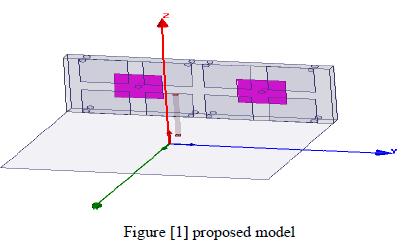 |
| In the above figure the highlighted patches are inner layer each unit cells is designed for 2GHz frequency antenna. And the antenna is monopole antenna with arm length 3.6cm and made with pec material operating at 2GHz. Design considerations: 8.37×3.5 cm Base plane of HIS. 1.5×1.5cm Metallic patches. 0.5cm height and 0.1cm radius pin vias. Are used for designing the High impedance ground plane of two-layers. |
SIMULATED RESULTS |
| The proposed model is designed and simulated using Ansoft HFSS software and the simulated results are illustrated in the following. |
| Case 1: When two inner plates are kept unchanged and the HIS is placed at one side of the antenna then the radiation occurs as shown in the figure [2]. |
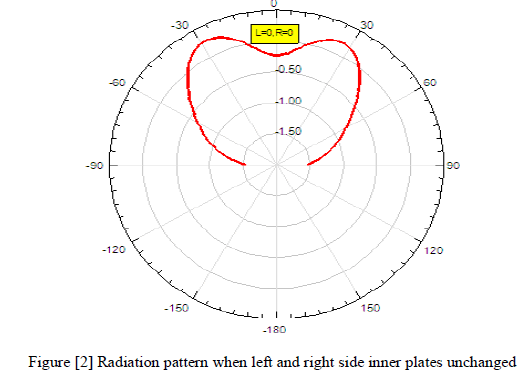 |
| Case 2: when the left side inner plate is rotated to 60° and right side plates is unchanged then the radiation patterns is shown in the figure [4]. |
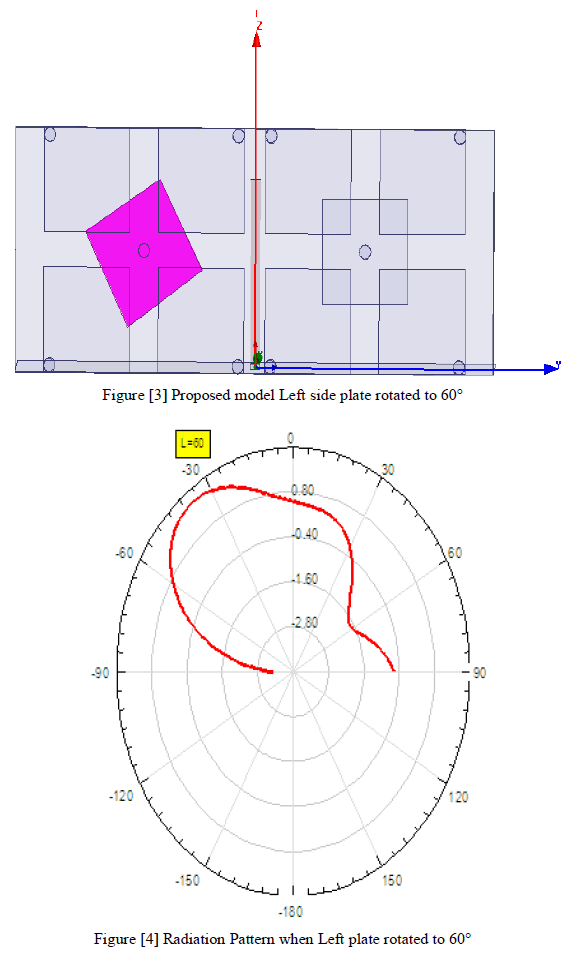 |
| From the above figure [4] we can clearly see that the radiation pattern is shifted to left side when the left plate is rotated. |
| Case 3: when the right side inner plate is rotated to 60° and right side plates is unchanged then the radiation pattern is shown in the figure [6]. |
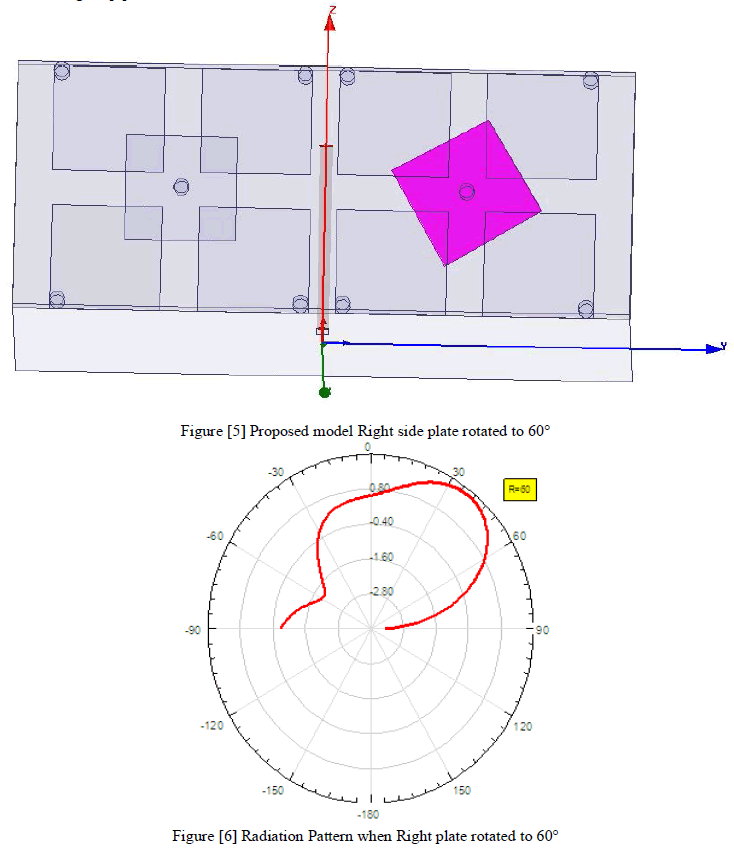 |
| From the above figure [6] we can say that the radiation reconfigured to right side when the right plate is rotated. |
| Case 4: similarly we perform the rotation of left and right plates simultaneously and the overall comparison is shown in the figure [7]. |
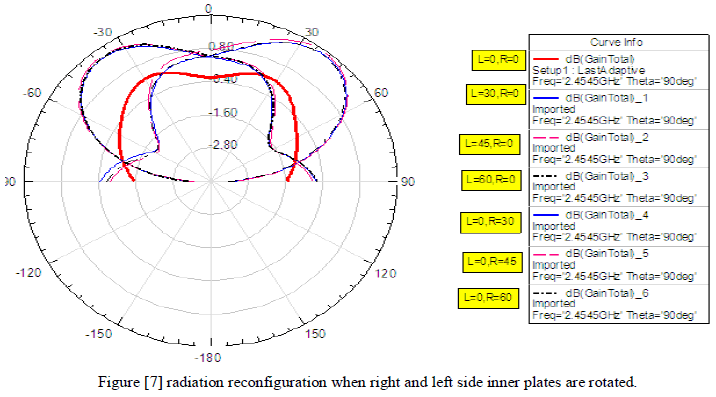 |
| From the above figure we can say that when left side plate is rotated than the radiation will shifted to left side and when the rotation is changing the radiation will enhance in that direction up to some rotation and will again decreases after some rotation and vice versa. |
CONCLUSION |
| This paper concludes the idea of radiation reconfiguration using the movable two-layered High impedance ground planes. By the rotation inner plates we can move the radiation to the desired direction. Here rotation of plates will change the phase of the radiation and results it into new direction as illustrated in the results. |
References |
|